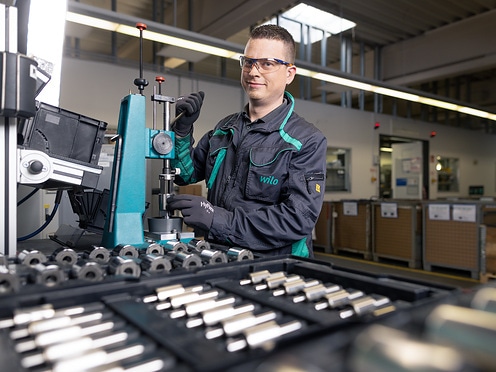Orkney: green islands, green hydrogen
The Scottish Orkney Islands have long since completed their energy transition: They produce more electricity than they themselves need with wind, wave and tidal power. To ensure that this electricity is not lost, the islands have opted for green hydrogen. They use it as fuel for cars, ferries and planes, among other things.
This text is part of Wilo's annual report 2022.

Developing a hydrogen aircraft
19 January 2023, Gloucestershire Airport, England: The twin-engine Dornier 228 aircraft taxis onto the runway and takes off. Instead of relying on kerosene for its power as usual, the left engine is powered by hydrogen. The aircraft touches down again a few minutes later. The maiden flight of the 19-seater aircraft has been a success. Eight weeks earlier and 100 kilometres further south: At the military airport of Boscombe Down, the engine manufacturer Rolls-Royce and the airline Easyjet test a hydrogen-powered engine on the ground. The European Marine Energy Centre (EMEC) was involved in both projects using green hydrogen in aviation. The centre is based on the Orkney Islands off the north-eastern coast of Scotland. And that’s no coincidence.
Green electricity from wind, waves and the tide
The inhabitants of the Orkney Islands have harnessed high waves, bitter winds and extreme tidal currents for many years to produce green electricity. The archipelago off the north-eastern coast of Scotland is made up of more than 70 islands. In total, around 22,000 people live on the 20 inhabited islands and are often known as “Orcadians”. They have benefited from the British government’s decision in 1980 to designate the archipelago a test region for wind power. More than 700 wind turbines power generators. In addition, there are plants that use wave and tidal power. This produces so much electricity that the inhabitants of the islands are completely self-sufficient in terms of energy and can also export it to the mainland. They use an old subsea cable that previously supplied them with electricity. However, this cable has a limited capacity.
Green hydrogen for electricity storage
The energy that is neither used by the islanders themselves nor supplied to the mainland risks being wasted. To make sure this does not happen, they produce green hydrogen. This is hydrogen produced from water by electrolysis using electricity generated from renewable sources. Green technology is used to create a sustainable energy source that does not require the use of fossil fuels. And the gas has other advantages: It can be stored and transported and can therefore make an important contribution to energy security. Moreover, it is also suitable as a raw material for ammonia, which is needed in many industries.
Leading the way in Europe
When it comes to green hydrogen, the Orkney Islands are leading the way throughout Europe. They have carved out this role for themselves: For many years, their inhabitants have been focussed on how to best use and store their renewable energy. That’s why several public institutions founded the European Marine Energy Centre there back in 2003. This is a research centre for energy from wind and tidal power and has now also been involved in the aircraft tests in the south of England. In 2009, the island community adopted a sustainable energy strategy with the aim of securing an affordable and efficient energy supply in the long term and reducing the islands’ carbon footprint. In 2017, the islanders revised their strategy for the period up to 2025. The focus is now on a vision of a secure, sustainable and low-carbon island economy focused on innovations in energy supply. This vision also includes a hydrogen strategy. This specifies how the gas can be used.
Heating a school with hydrogen
The strategy was preceded by concrete action: Back in 2015, the EMEC launched the pilot project “Surf ’n’ Turf” on its tidal test site on the Orkney Island of Eday. The electrolyser used the tidal energy to produce hydrogen. Specially developed lorries transported the hydrogen to the capital of Orkney, Kirkwall. There, it was used as an energy source for ferries at the harbour. The follow-up project “Big Hit” aimed to develop a green hydrogen energy system on the Orkney Islands. The islanders thus pursue an integrated approach with which they can produce, store and transport hydrogen for subsequent use in heat, electricity and transport. The hydrogen produced as part of the project was used, among other things, to supply heat to a school and as fuel for municipal vehicles. With “Big Hit”, the Orkney Islands took the step of becoming one of the first locations in the world to operate facilities across the entire hydrogen value chain.
New research fields: artificial intelligence and synthetic fuels
The experiences from these and other projects mean that there is a wealth of knowledge about hydrogen on the islands, which is in demand across the United Kingdom and beyond. Such as in the two aircraft tests: The hydrogen for the Rolls Royce test came from the EMEC production and tidal test plant on the Orkney Island of Eday. The EMEC provided a mobile hydrogen refuelling system to refuel the Dornier 228 in Gloucestershire. The institute has thus demonstrated what the ground infrastructure that can be used to produce, store and refuel hydrogen might look like. And the researchers on the archipelago already have other projects in the pipeline: For example, the institute is currently testing, among other things, how hydrogen production on the island can be optimised using artificial intelligence and how synthetic hydrocarbon-based fuels can be produced for aircraft.
Green hydrogen: a global trend
With green hydrogen, the Orkney Islands identified a trend early on that companies and governments around the world are currently addressing. There is great interest in the renewable energy source in Germany too: Last September, the multinational technology group Wilo commissioned its own hydrogen plant with the H2POWERPLANT at the company’s headquarters at the Wilopark in Dortmund. How to produce green hydrogen is a global issue. When it comes to technology and innovative applications, a lot of knowledge is concentrated at the northern extremity of Scotland.

Green hydrogen: energy transition on the Orkney Islands
The Orkney Islands in northern Scotland produce electricity from wind, wave and tidal power – more than they themselves can use. They use surplus energy to produce green hydrogen. The European Marine Energy Centre (EMEC) for research, which was founded on the islands back in 2003, plays a key role here. The islands’ inhabitants have already implemented numerous projects and built up extensive knowledge of green hydrogen with its help. They use this knowledge, for example, to experiment with hydrogen as a power source for aircraft, thus leading the way throughout Europe.


















